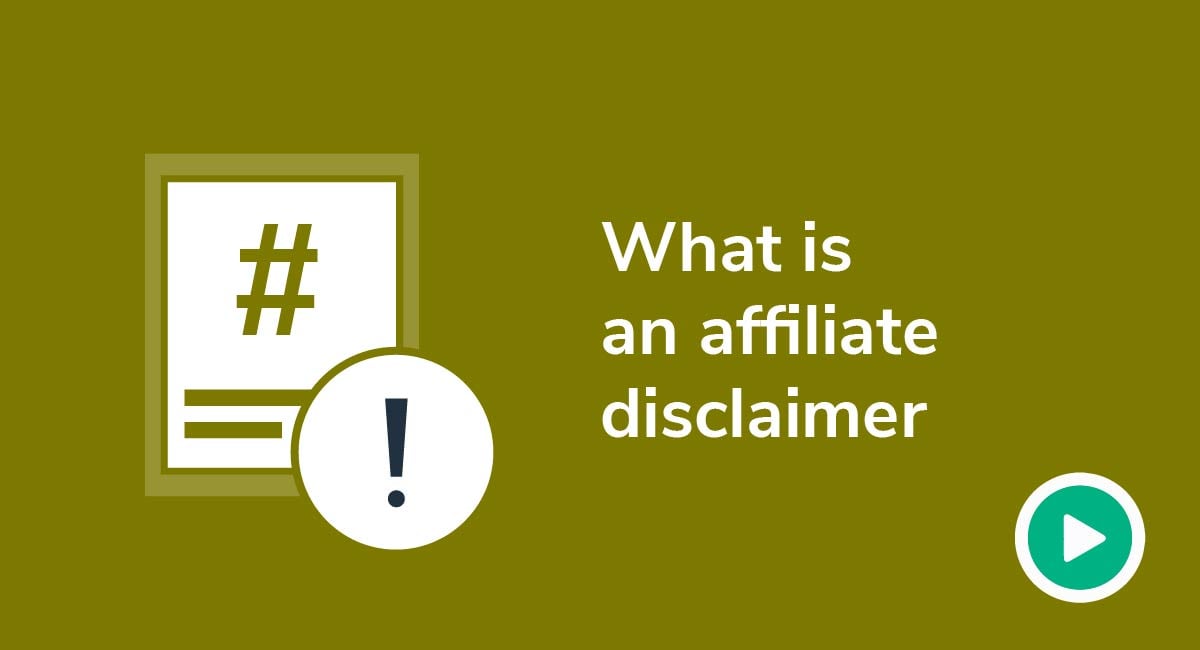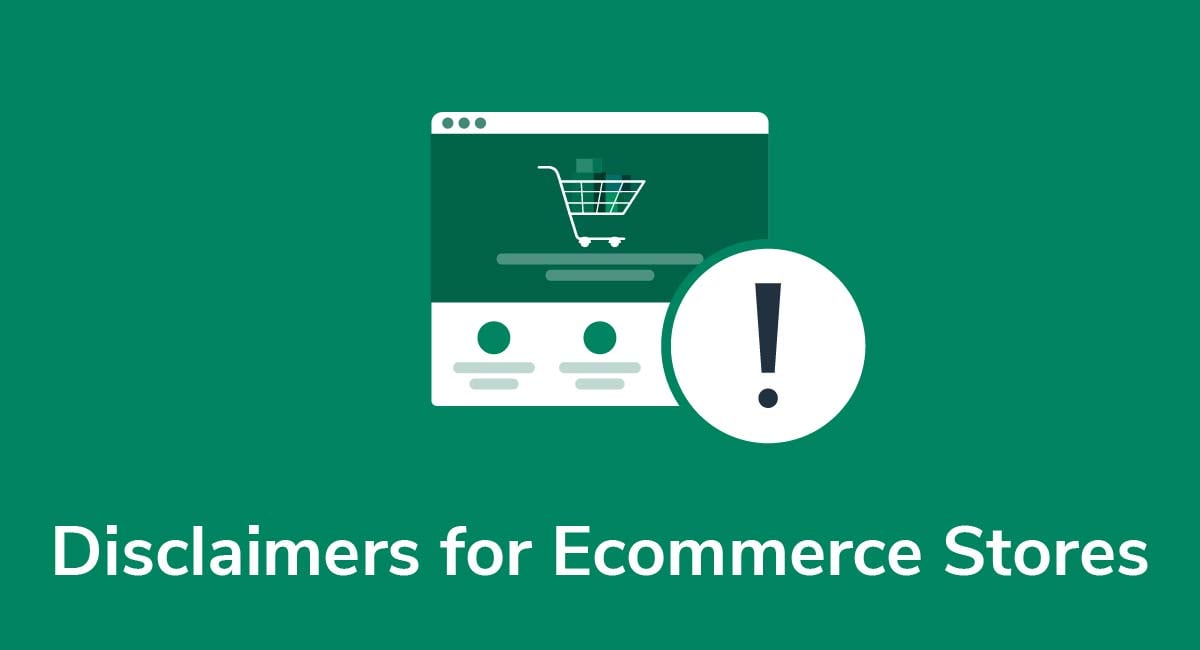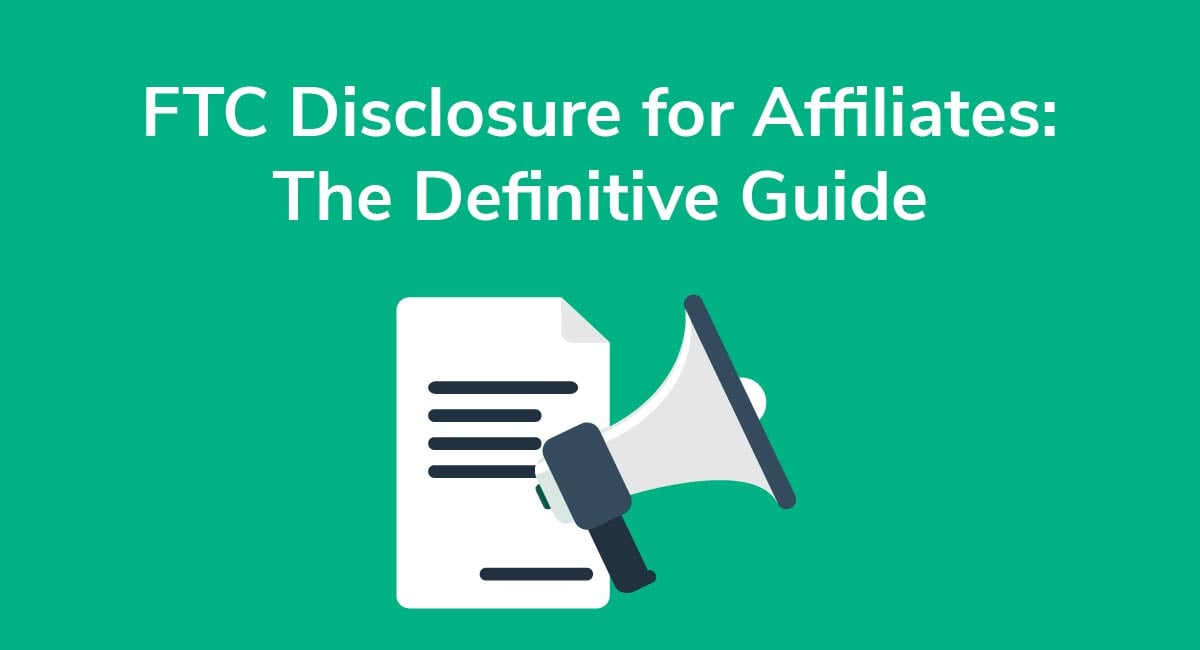Disclaimers for Presentations
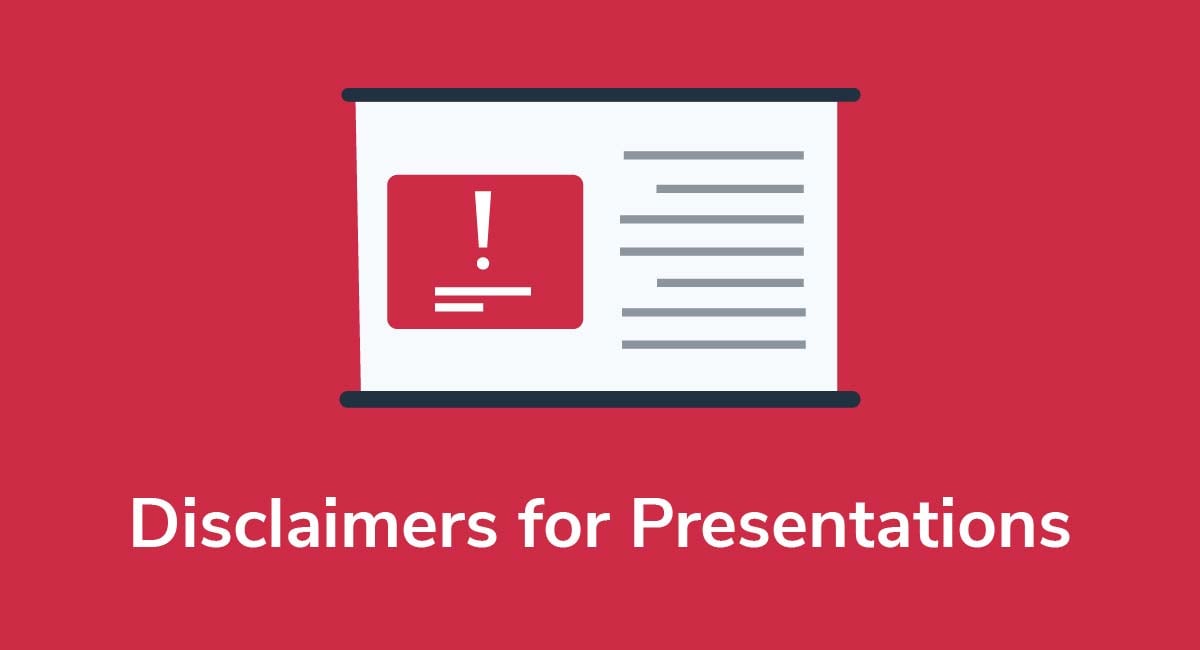
Disclaimers are statements that limit liability by informing users that you (or your organization or employer) aren't responsible for real or perceived damages that may arise from using your product or service.
Disclaimers are found on most websites and mobile apps, but they're also common with in-person and online presentations because they minimize risk and promote transparency.
In this article, we'll cover what disclaimers are, why they're vital for presentations, and what to include in yours.
Get compliant today with PrivacyPolicies.com
Select one of our generators to create the required legal agreements for your business:
- Our Privacy Policy Generator can help you generate a customized Privacy Policy in around three minutes, for free.
- Our Terms & Conditions Generator can help you generate a customized Terms & Conditions agreement in around three minutes, for free.
- Our EULA Generator can create a customized End-User License Agreement for your mobile or desktop app.
- Our Cookies Policy Generator can create a customized Cookies Policy to help your compliance with ePrivacy Directive and GDPR.
- Our Disclaimer Generator can create a disclaimer or disclosure for your website.
- Our Return & Refund Policy Generator can help your ecommerce store by creating a returns or refunds policy.
Integrate a free Cookies Notice and Cookie Consent banner to comply with the EU ePrivacy Directive and the new GDPR law regarding cookies.
- 1. Why Have a Disclaimer for Your Presentation?
- 2. What to Include in Your Presentation Disclaimer
- 3. Common Disclaimers for Presentations
- 3.1. Limitation of Liability
- 3.2. Errors and Omissions
- 3.3. Fair Use
- 3.4. Confidentiality
- 3.5. Views Expressed
- 3.6. Affiliate Links
- 3.7. Copyright
- 3.8. Use at Your Own Risk
- 4. When, Where and How to Display Your Presentation Disclaimer
- 5. Summary
Why Have a Disclaimer for Your Presentation?
Disclaimers aren't legally required for most presentations, but you may need one if you'll be sharing information that could be construed as legal, medical, or financial advice.
Even when not legally required, it's wise to include a blanket disclaimer or a number of specific disclaimers.
The more thorough and specific your disclaimer, the more protections it will afford you, the host, and the venue.
What to Include in Your Presentation Disclaimer

When crafting a disclaimer for a presentation, it's important to consider your intent as well as the nature of the event and the information you'll be presenting.
For example, is your presentation for entertainment or educational purposes? Will you be presenting facts to support your claims and assertions, or will your presentation consist mainly of opinion or speculation? Will you be giving advice or anything that can be construed as advice?
You may want to address the following in your presentation disclaimer:
- Your education, experience, and qualifications
- Whether information from outside sources will be used
- The limitations of your liability
- Whether the event will be filmed or recorded
- Who's sponsoring the event
- Any conflict of interest issues
Common Disclaimers for Presentations

Here are some of the most commonly used disclaimers. While not all will apply to all situations, having one or more of them may be the way to go.
Limitation of Liability
As with websites and mobile apps, presentation attendees and remote viewers can have negative experiences, and when they do, they may choose to claim damages.
Without a limitation of liability disclaimer, the sky's the limit for claims and potential liability.
Here's how TED discloses its limitations of liability:

TED makes it clear that it isn't liable for any damages and includes a concise summary to the right of the main text to ensure users can't claim they didn't understand the legal jargon. This is a great way to get this information across in your presentation in a way that covers legality while being user friendly.
Errors and Omissions
Errors and Omissions disclaimers are important for presentations because, despite your best efforts, you may have inadvertently misstated facts, incorrectly analyzed data, or drawn erroneous conclusions.
By including an errors and omissions disclaimer, you'll protect yourself from liability and financial damages in the event of either errors or omissions.
Fitness Blender addresses errors and omissions as follows:

It's also important to address issues of age and inaccuracy if your presentation was posted on say a YouTube channel years ago but is still being watched. If so, viewers may assume that the information is timely and relevant even if it's outdated and obsolete.
A disclaimer noting this can help ensure users are aware that the information may be outdated, and that if it is, it isn't your fault if damages arise from following it.
Fair Use
Fair use disclaimers aren't required for presentations, but it's wise to include one if you'll cite or use material from outside sources.
Under the terms of the Fair Use Act, you may be permitted to use certain copyrighted material in your presentation without a license or permission, especially if you'll be commenting on or critiquing it or using it for educational or research purposes.
You can also use a fair use disclaimer to let presentation attendees, viewers, and participants know that they may be able to use some or all of the information that you present.
Here's how Multiple Chronic Conditions Resource Center addresses Fair Use:
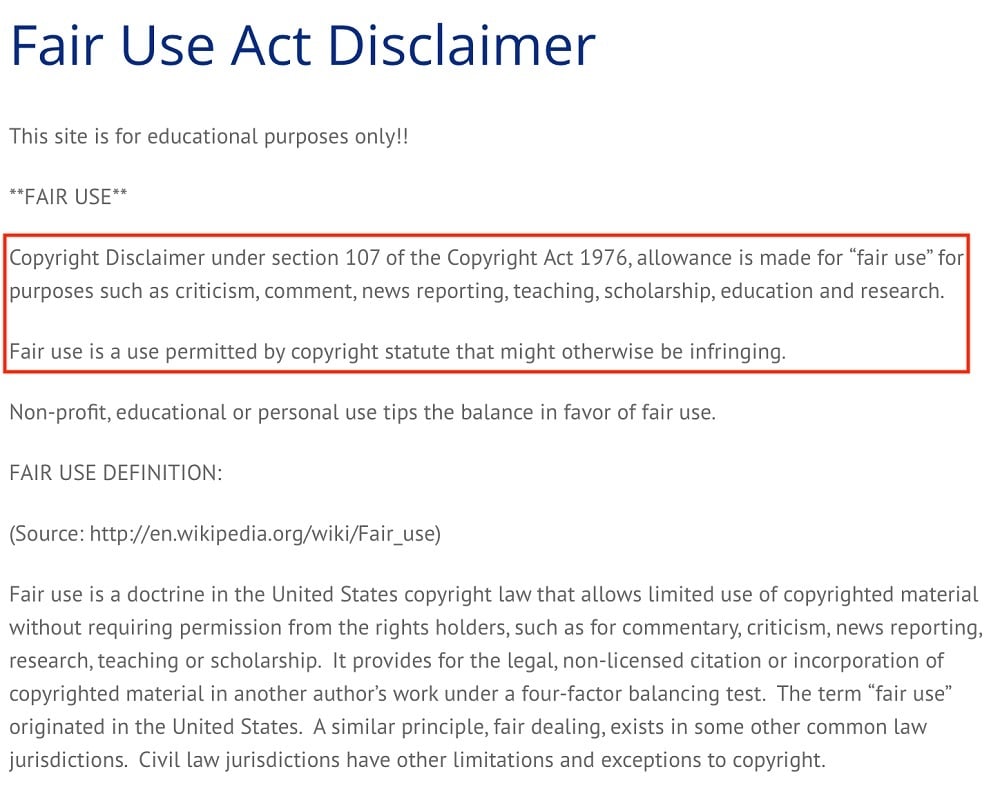
It's worth noting that fair use isn't always cut and dry, and that even a well-written disclaimer won't protect you if you're using someone else's material inappropriately or without the proper authorization.
Confidentiality
Many presentations aren't open to the public or shared on public platforms like YouTube. In fact, sensitive and proprietary information is usually only intended for registered guests who attend private meetings reserved for company shareholders, board members, or executives.
When this is the case, a confidentiality disclaimer will let attendees know that the information you'll be delivering is for their eyes and ears only.
Here's how the Royal Academy of Music notes that materials it sends out, such as presentations, may contain confidential information that is not meant to review, distribute or otherwise do anything with the content:
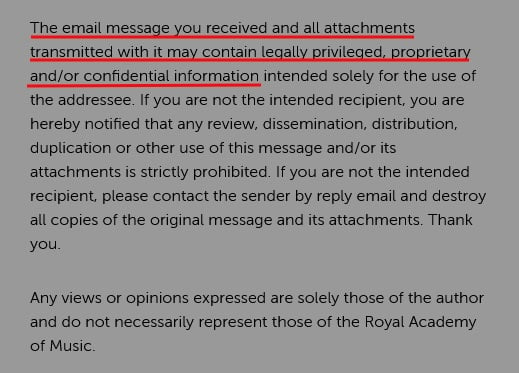
Views Expressed
It's not uncommon for presenters to add personal opinions that may not necessarily align with those of the employer, organization, or host venue.
That's where a views expressed disclaimer is helpful because it provides a separation between you (the presenter) and the other parties involved in the event.
In your views expressed disclaimer, you can let users know that your opinions are your own and do not reflect that of anyone else.
In its Podcast Disclaimer, the Federal Communications Commission (FCC) informs listeners that podcasts are a public service and that the information contained in them shouldn't be mistaken for official statements of policy:

Though specifically for podcasts, the FCC's disclaimer could be easily adapted for virtual, in-person, or prerecorded presentations as well. The general concept remains the same no matter how, where or when such a disclaimer is used.
Affiliate Links
Oftentimes presentations are given to promote a product or a service. In these cases, there will often be affiliate links included or promo codes shared where if the viewers purchase the product in the presentation, the presenter will get a financial reward from the company.
If you engage in affiliate marketing like this, you are legally required by the FTC in the United States to include an affiliate disclaimer. Amazon also requires a disclaimer if you're part of its affiliate program.
In your affiliate disclaimer you need to disclose that you use affiliate links, and that you may earn money or other material benefits if the links are used.
Here's how Dr. Lyss includes a disclaimer on a page where she promotes products she sells via affiliate links:

You can see how this format can translate nicely into text in a presentation slide before you post affiliate links that users can click on.
Copyright
For added protection for your creative content and intellectual property used in your presentation, you can include a copyright disclaimer.
This simple notice will help remind viewers that they can't just take the presentation and show it to others as they want, or take parts of it to use in their own presentations.
You can include a short copyright notice at the bottom of every slide if you want, like Reuters does here:
![]()
Or for a more discreet style, include the copyright information with the rest of your disclaimers. Here's how a more wordy copyright disclaimer can look, from Reuters:
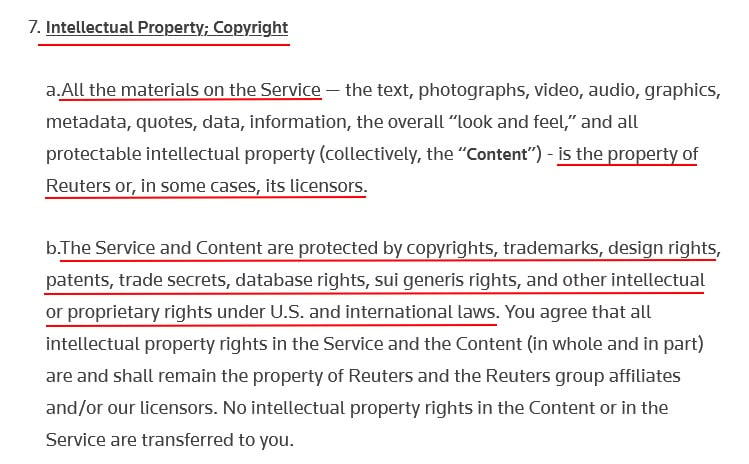
Use at Your Own Risk
To help protect yourself against liability, it's a smart idea to remind users that any information you provide is to be used at the person's own risk. For example, say you give a presentation about a new diet. It may actually be harmful for some people in some conditions to practice the diet. This is where a "use at your own risk" statement can be legally helpful to you.
Other scenarios where this is common is if the viewers of the presentation may incur financial loss by acting on information you provide, or if you address topics where data changes rapidly, such as with stock, commodity, and precious metal prices.
In its Risk Warning, Gold Price warns users that it provides information deemed to be reliable. However, the company doesn't guarantee accuracy, and its precious metals charts are provided without warranty or claim of reliability:

In addition, it states that readers are responsible for doing their own due diligence before acting on any of the information provided.
When, Where and How to Display Your Presentation Disclaimer

It's a good idea to present your disclaimer before jumping into your presentation.
You may want to provide attendees with a copy of your disclaimer prior to them showing up to the event by including a link or a full copy at registration, or checkout if they're paying via credit card.
Even if you've made your disclaimer available before the event, it's still wise to read it in its entirety, give attendees a physical copy, or present it in slide form before beginning.
Disclaimers may be delivered orally as well, in addition to the other methods of delivery.
If you give presentations on YouTube, there are a number of ways to include disclaimers there. Check out our feature article for more information: Disclaimers for YouTube Videos
Disclaimers are often linked to on website footers. This is especially true when there's an online component to an in-person or web-based presentation or when an organization has one overarching disclaimer.
Website footers are popular locations for disclaimers because they often contain links to other important information such as Privacy Policies, and most users know to look for important information there.
In the example below, Gold Price places its disclaimer link between its Risk Warning and Terms links at the bottom of its website:

Many health and fitness-related YouTube channels display disclaimers before getting into the main content of their videos.
Here's how Dr. Sten Ekberg Disclaims liability before a video in which he documents his experience eating 100 tablespoons of butter in 10 days:
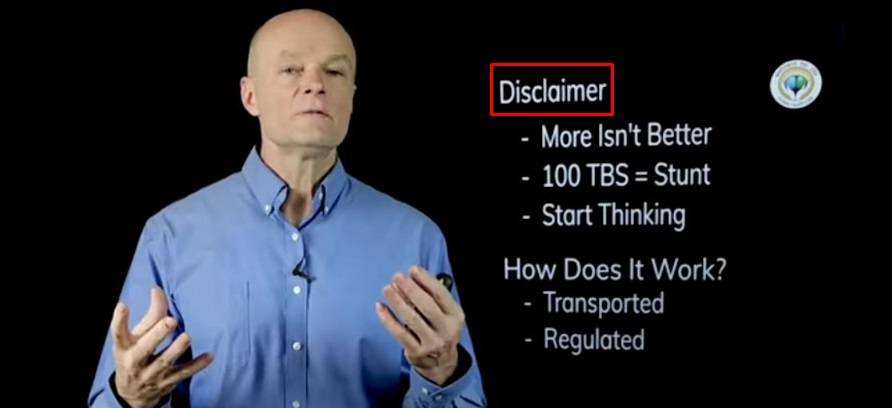
Likewise, the popular fitness and weight training channel More Plates More Dates typically displays disclaimers similar to the one below before any content is delivered:
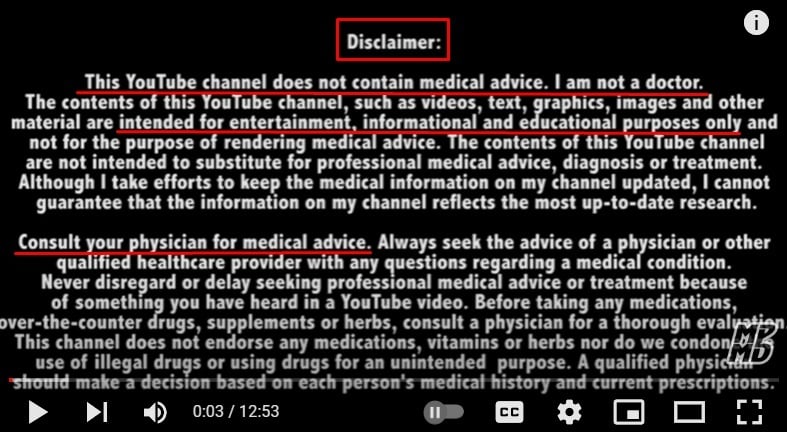
Because much of its content could be mistaken for health or medical advice, the disclaimer states that the presenter isn't a doctor, that videos are for entertainment, informational, and educational purposes only, and that viewers should consult a physician for actual medical advice.
In addition, disclaimers for presentations can be included on or linked to in the following places:
- E-invites
- Marketing copy or emails
- Pop-up notifications on websites and mobile apps
- Online registration forms and checkout pages
- At the bottom of each slide in a multi-slide presentation
Summary
As with websites and mobile apps, presentation attendees and remote viewers may feel like they're entitled to damages when they have negative experiences.
In addition to promoting transparency, disclaimers for presentations protect presenters by limiting liability.
Disclaimers aren't legally required for most presentations, but you may need to include one if you'll be sharing legal, medical, or financial information.
Even when not legally required, it's wise to protect yourself by including a well-written disclaimer.
When crafting your disclaimer, you may want to address the following:
- Your experience, education, and qualifications
- Will you be presenting supporting facts?
- Will your presentation include opinions and theories?
- Whether the event is being filmed or recorded
- Your relationship with hosts and sponsors (and any other conflict of interest issues)
Though they're generally tailored to the particulars of each presentation, you may want to include the following sections in your disclaimer:
- Limitations of Liability - Neither you, your employer, your organization nor the venue are liable for real or perceived damages
- Errors and Omissions - You're not responsible if the information presented contains errors or omissions
- Fair Use - Some copyrighted material can be used without license or permission, especially for comment, critique, research, and education
- Confidentiality - Presentation viewers may have access to sensitive and proprietary information not meant for other parties
- Views Expressed - The views expressed in your presentation are yours only and not anyone else's
- Affiliate Links - You will get a material benefit when viewers use your links to purchase products or sign up for services
- Copyright - Make clear that your content is yours and is not to be reused elsewhere without your permission
- Use At Your Own Risk - The presentation viewers are using any of your advice or information solely at their own risk
Include your disclaimers within the presentation itself, such as on a title screen and/or at the bottom of your slides.
